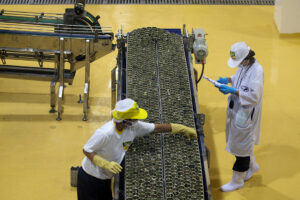




Policy Rate Updates: Double cut finale
 DOWNLOAD
DOWNLOAD

Monthly Economic Update: One for the road
 DOWNLOAD
DOWNLOAD

Inflation Update: Still low, still slow
 DOWNLOAD
DOWNLOAD


Manufacturing output up 1.9% in November

Factory output expanded in November, but the activities related to food items continued to drag the overall manufacturing sector.
Preliminary results of the Philippine Statistics Authority’s (PSA) latest Monthly Integrated Survey of Selected Industries showed factory output, as measured by the volume of production index (VoPI), rose by 1.9% year on year in November.
The November output was faster than the revised 1.5% recorded in October.
This is the highest print in two months or since the 10.4% recorded in September.
On a monthly basis, November’s output grew by 2.7%, a reversal from the 1.2% contraction in the previous month. Stripping out seasonality factors, manufacturing that month edged up by 0.7%, a reversal from the 4.1% drop in October.
Year to date, factory output averaged 5.1%, lower than the 45% growth a year ago.
To compare, S&P Philippines Manufacturing Purchasing Managers’ Index (PMI) rose to 52.7 in November, higher than the of 52.4 in October. A PMI reading of above 50 means improvement in operating conditions compared with the previous month, while a reading below 50 shows deterioration.
PSA said the annual growth of the VoPI in November can be attributed to the faster rise in transport equipment (17.1% from 5.8% in October), as well as the smaller declines in beverages (-11.6% in November from -34.4% in October), and chemical and chemical products (-2.4% from -10.9%).
Several industry divisions posted slower growth, such as printing and reproduction of recorded media (8.6% from 26.3%), basic pharmaceutical products and pharmaceutical preparations (15.5% from 16.5%), electrical equipment (29.9% from 30.5%), and coke and refined petroleum products (37% from 46.9%).
However, the PSA said 13 industry divisions recorded annual declines during the month, led by machinery and equipment except electrical (-27% from -23.1%); leather and related products, including footwear (-26% from -29%); fabricated metal products, except machinery and equipment (-25.4% from -16.4%); wearing apparel (-24.3% from -20%); and wood, bamboo, cane, rattan articles, and related products (-20.2% from -42%).
Average capacity utilization — the extent to which industry resources are used in the production of goods — averaged 74.8% in November, slightly higher than October’s 74.3% in the previous month.
All industry divisions have reached an average capacity utilization rate of more than 60%.
“Manufacturing activity related to food items were the drag on overall manufacturing with production of other items compensating for the decline in those items. This may reflect the struggles experienced by the agriculture sector which posted negative growth in the third quarter,” ING Bank N.V. Manila Senior Economist Nicholas Antonio T. Mapa said in an e-mail.
Mr. Mapa added that the manufacturing industry will likely help support growth, but gross domestic product (GDP) growth will likely remain largely driven by the services sector. — By Lourdes O. Pilar, Researcher
This article originally appeared on bworldonline.com





 By BusinessWorld
By BusinessWorld